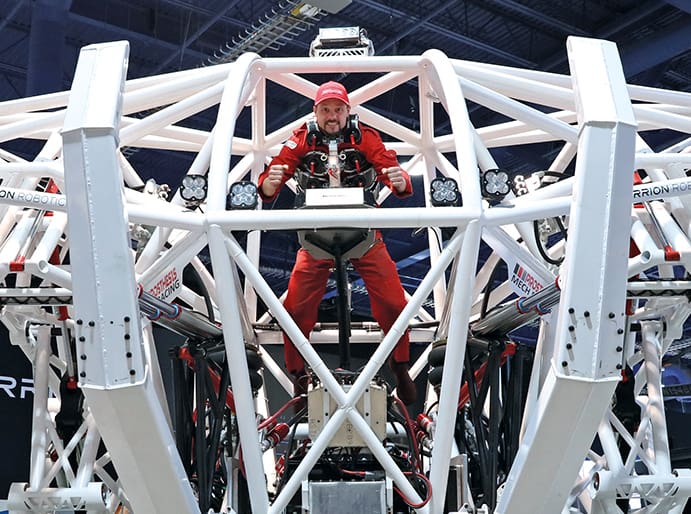If all this sounds like science fiction, that’s because it essentially is. Mechs have long been a popular sub-genre of science fiction, gaming and Japanese anime, but until now no one has made them a reality. Mechanical engineer and sculptor Jonathan Tippett, along with a big group of friends and volunteers, began working on the concept via their educational charity eatART (energy awareness through ART). At their workshop in Vancouver, the crew spent several years developing the Alpha Leg – a two-thirds-scale prototype limb that would lay the foundation for what was to follow. But it wasn’t until Matt Fidler, co-founder of tech company Furrion, saw the Alpha Leg that things took off.

“He was totally inspired by it,” Tippett told The Engineer at the recent SolidWorks World event in Los Angeles. “He thought it was just crazy enough to succeed.”
Having demonstrated the Alpha Leg, Tippett was able to sell the bigger picture to Furrion – full-scale mechs competing against each other in a racing league. Working with Furrion, Tippett set about building Prosthesis, a 5m-tall, 3,000kg, four-legged wearable machine, powered by a hybrid-electric power plant. Once operational, it will be able to clock nearly 30kmh and jump 3m in the air. Prosthesis was first unveiled in January, and loomed over Tippett and myself when we spoke in LA. The prospect of several of these monsters facing off in the desert is quite something.
Dream bigger
“The mech racing league used to be a fictional back story to support the art project, as a Burning Man-destined, single one-off thing,” said Tippett. “But it took so damn long to make, that 10 years down the road not only had our community and my resources and my skills expanded, but with Furrion on board we were able to dream bigger, and this fictional back story actually became a good idea.
“That was the original dream, just ripping around in the dirt, jumping over stuff. You could have a stadium track race, or you could have a long desert race. Basically any off-road or on-road motorsport could be done in a mech. Plus any track and field event. So it’s this crazy pan-spectrum platform for human competition.”
As with drone racing, controlling mechs will require extreme skill. The robots will have no autonomy, no gyroscopes to self-balance, no AI to assist the pilots. Despite their gargantuan size, they will be finely tuned machines designed to operate in sync with their onboard drivers, accentuating human skill rather than replacing it.
“You know there’s so much automation going on these days, I felt it was important to make something that was celebrating the process of human skill, and keeping the human agency central to the experience,” Tippett explained.
The pilot – who sits in the centre of the mech – controls the two outside limbs with their arms and the inside limbs with their legs, protected by a chromoly steel frame and lots of suspension. A fully functioning Prosthesis is due to be unveiled in May, and it’s been reported that the mech will appear at the first ever World Future Sports Games, set to take place in Dubai in December 2017. That event will also feature drone racing and driverless car racing, as well as robot soccer, robot swimming and, somewhat bizarrely, robot wrestling. It's a long way from the Olympiads of ancient Greece, but the spirit of competition remains unchanged, and the action promises to be fascinating.





Nanogenerator consumes CO2 to generate electricity
Nice to see my my views being backed up by no less a figure than Sabine Hossenfelder https://youtu.be/QoJzs4fA4fo